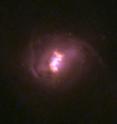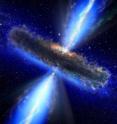Universe's hidden supermassive black holes revealed
Astronomers have found evidence for a large population of hidden supermassive black holes in the Universe. Using NASA's Nuclear Spectroscopic Telescope Array (NuSTAR) satellite observatory, the team of international scientists detected the high-energy x-rays from five supermassive black holes previously clouded from direct view by dust and gas.
The research, led by astronomers at Durham University, UK, supports the theory that potentially millions more supermassive black holes exist in the Universe, but are hidden from view.
The findings are being presented at the Royal Astronomical Society's National Astronomy Meeting, in Llandudno, Wales, today (Monday, July 6, 2015).
The scientists pointed NuSTAR at nine candidate hidden supermassive black holes that were thought to be extremely active at the centre of galaxies, but where the full extent of this activity was potentially obscured from view.
High-energy x-rays found for five of the black holes confirmed that they had been hidden by dust and gas. The five were much brighter and more active than previously thought as they rapidly feasted on surrounding material and emitted large amounts of radiation.
Such observations were not possible before NuSTAR, which launched in 2012 and is able to detect much higher energy x-rays than previous satellite observatories.
Lead author George Lansbury, a postgraduate student in the Centre for Extragalactic Astronomy, at Durham University, said: "For a long time we have known about supermassive black holes that are not obscured by dust and gas, but we suspected that many more were hidden from our view.
"Thanks to NuSTAR for the first time we have been able to clearly see these hidden monsters that are predicted to be there, but have previously been elusive because of their 'buried' state.
"Although we have only detected five of these hidden supermassive black holes, when we extrapolate our results across the whole Universe then the predicted numbers are huge and in agreement with what we would expect to see."
Daniel Stern, the project scientist for NuSTAR at NASA's Jet Propulsion Laboratory in Pasadena, California, added: "High-energy X-rays are more penetrating than low-energy X-rays, so we can see deeper into the gas burying the black holes. NuSTAR allows us to see how big the hidden monsters are and is helping us learn why only some black holes appear obscured."
The research was funded by the Science and Technology Facilities Council (STFC) and has been accepted for publication in The Astrophysical Journal.
Source: Durham University
Articles on the same topic
- NASA's Fermi sees record flare from a black hole in a distant galaxyFri, 10 Jul 2015, 20:11:36 UTC
- NASA's Swift reveals a black hole bull's-eyeThu, 9 Jul 2015, 21:05:59 UTC
- A precocious black holeThu, 9 Jul 2015, 18:39:02 UTC
- Astronomers find a massive black hole that outgrew its galaxyThu, 9 Jul 2015, 18:38:49 UTC
- A black hole under the gravitational lensThu, 9 Jul 2015, 18:38:35 UTC
Other sources
- Amazing flare from a black hole in a distant galaxyfrom Science DailySat, 11 Jul 2015, 20:00:07 UTC
- Fermi detects record flare from distant black holefrom UPIFri, 10 Jul 2015, 21:50:12 UTC
- Fermi sees record flare from a black hole in a distant galaxyfrom PhysorgFri, 10 Jul 2015, 20:30:21 UTC
- Week's Best Space Pictures: Black Hole Bursts, Storms Swirlfrom National GeographicFri, 10 Jul 2015, 19:00:09 UTC
- Black hole bull's-eye revealedfrom Science DailyFri, 10 Jul 2015, 13:10:27 UTC
- Distant black hole wave twists like giant whipfrom PhysorgFri, 10 Jul 2015, 11:10:17 UTC
- Swift satellite reveals a black hole bull's-eyefrom PhysorgThu, 9 Jul 2015, 22:00:34 UTC
- Astronomers find a massive black hole that outgrew its galaxyfrom Science DailyThu, 9 Jul 2015, 19:30:18 UTC
- Distant Black Hole Wave Twists Like Giant Whipfrom NASA Jet Propulsion LaboratoryThu, 9 Jul 2015, 18:32:03 UTC
- Ancient black hole defied rules of galaxy formationfrom PhysorgThu, 9 Jul 2015, 18:30:57 UTC
- Enormous Black Hole Is Too Big for Its Galaxyfrom Space.comThu, 9 Jul 2015, 18:30:31 UTC
- Massive black hole lurks in lightweight galaxyfrom Sciencenews.orgThu, 9 Jul 2015, 18:10:20 UTC
- Astronomers see black hole come to lifefrom Science DailyThu, 9 Jul 2015, 15:00:19 UTC
- Astronomers See Black Hole Come to Lifefrom Newswise - ScinewsThu, 9 Jul 2015, 13:30:47 UTC
- Best-candidate supernova erupting every year and on the brink of catastrophefrom PhysorgThu, 9 Jul 2015, 11:30:18 UTC
- Radio astronomers see black hole come to lifefrom PhysorgThu, 9 Jul 2015, 11:30:17 UTC
- A black hole under the gravitational lensfrom Science DailyWed, 8 Jul 2015, 16:01:04 UTC
- Astronomers teach a machine to analyse galaxy imagesfrom PhysorgWed, 8 Jul 2015, 13:30:33 UTC
- The dark side of galactic radio jetsfrom PhysorgWed, 8 Jul 2015, 11:30:18 UTC
- Millions of black holes hidden behind veils of dustfrom CBSNews - ScienceTue, 7 Jul 2015, 14:00:04 UTC
- Astronomers use cosmic gravity to create a 'black-hole-scope'from PhysorgTue, 7 Jul 2015, 11:20:17 UTC
- NuSTAR Stares Deep into Hidden Lairs of Black Holesfrom NASA Jet Propulsion LaboratoryMon, 6 Jul 2015, 17:20:16 UTC
- Astronomers use cosmic gravity to create a ‘black-hole-scope’from European Space AgencyMon, 6 Jul 2015, 15:20:30 UTC
- Universe's hidden supermassive black holes revealedfrom PhysorgMon, 6 Jul 2015, 11:00:13 UTC
- Universe’s hidden supermassive black holes revealedfrom Science DailyMon, 6 Jul 2015, 2:00:15 UTC


